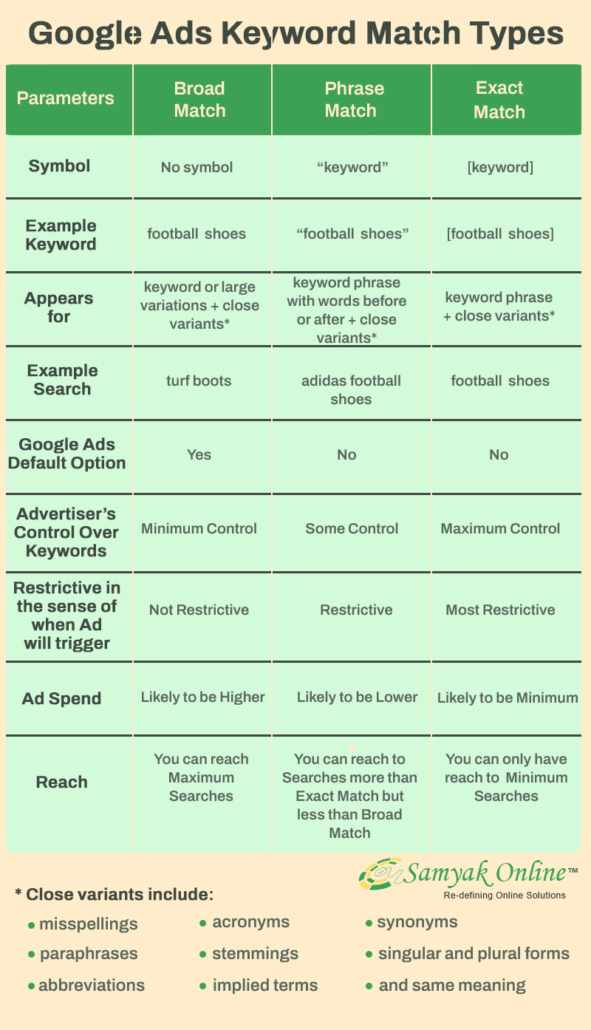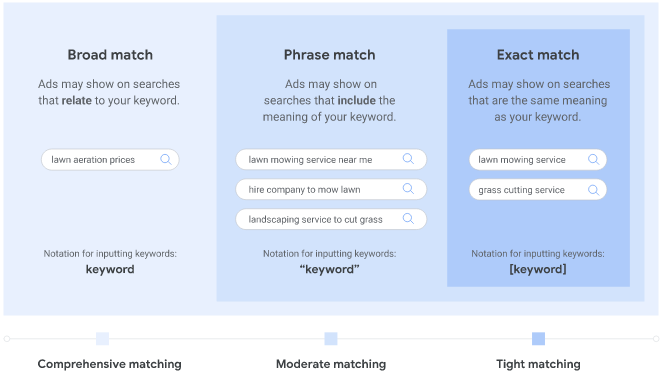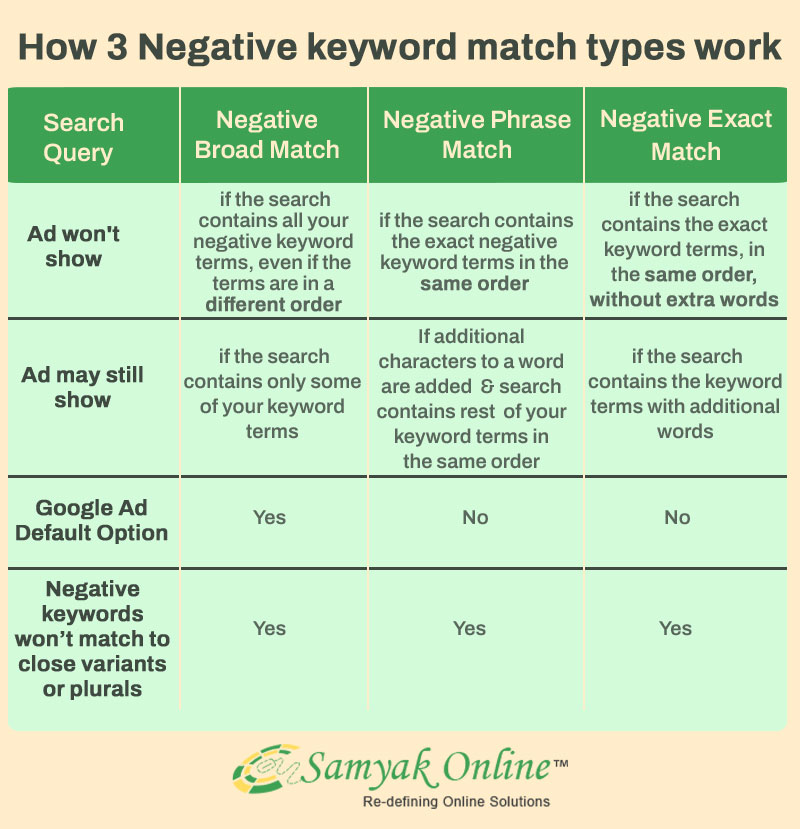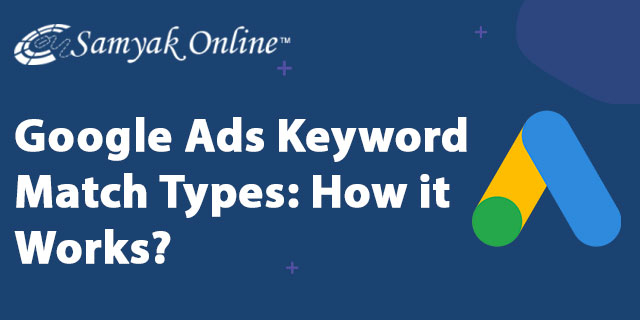Google Ads Keyword Match Types: How it Works?
Last Updated on April 3, 2024 by Subhash Jain
In February 2021, Google made significant changes in its Ads keyword match types that forced SEOs to change their keyword selection strategy.
If you are experiencing a drop in the outcome of a Google Ads campaign in last couple of years, not choosing the right keyword for appropriate match type may be a reason. You might be working with high-performing keywords for Google Ads but you might not be working with right keyword match type and spending your budget for little gain. Yes, the difference between both approaches creates a difference in the results of paid digital marketing. Updating keyword match type campaign strategy powered by the latest Google match type update is a must to get satisfactory marketing benefits. This blog will help you select the right keyword match type to separate your ad campaign from a traditionally planned ad campaign based on keyword potential. So, What is keyword match type?
Keyword match type tells Google how to relate your advertisements to users’ queries. Correct selection of keyword match type increases the ROI of Google Ad campaigns by minimizing unqualified traffic. Keyword match type is a parameter that decides the limits for appearing your ads in response to the particular set of queries.
What Are Different Keyword Match Types?
When you bid on a keyword for a PPC campaign, you choose a particular keyword match type to tell Google how restrictively or aggressively, it should relate your advertisement to user queries. To optimize the visibility of your paid ads in searches for getting high-potential leads, you must consider three keyword match types:
1.Broad Match Type: This keyword match type maximizes reach but the traffic often has low relevance to your products/services. For example, “men’s clothing” keyword will make your ad appear in searches for men’s clothing, discounted men’s clothing, clothing for men, men’s apparel, men’s dress etc. It is denoted as men’s clothing.
2.Phrase Match Type: This keyword match type has a medium reach to get medium-level relevance to your products/services. It is denoted as “men’s clothing” under double quotes.
3.Exact Match Type: This keyword match type has minimum reach but traffic has max relevance to your products/services. It is denoted as [men’s clothing].
The Comparative View of All Three Keyword Match Type
| Parameters | Broad Match | Phrase Match | Exact Match |
| How Google defines it? (Source: Google) | Ads may show on searches that are related to your keyword, which can include searches that don’t contain the keyword terms. | Ads may show on searches that include the meaning of your keyword. | Ads may show on searches that have the same meaning or same intent as the keyword. |
| What does it mean for us to interpret? | Searches that may show on Ads that trigger on search query that are related to keywords. | Searches that may show on Ads that trigger on search query that are implied to keyword or include the meaning of keyword. | Searches that may show on Ads that trigger on search query that have the same meaning or same intent as the keyword. |
| Matching | Loose Matching | Moderate Matching | Tight Matching |
| Symbol | No symbol | “keyword” | [keyword] |
| Example Keyword | football shoes | “football shoes” | [football shoes] |
| Appears for | keyword or large variations + close variants* | keyword phrase with words before or after + close variants* | keyword phrase + close variants* |
| Example Search | turf boots | adidas football shoes | football shoes |
| Google Ad Default Option | Yes | No | No |
| Advertiser’s Control Over Keywords | Minimum Control | Some Control | Maximum Control |
| Restrictive in the sense of When Google will trigger Add | Not Restrictive | Restrictive | Most Restrictive |
| Ad Spend | Likely to be Higher | Likely to be Lower | Likely to be Minimum |
| Reach | You can reach Maximum Searches | You can reach to Searches more than Exact Match but less than Broad Match | You can only have reach to Minimum Searches |

Google Ads Keywords Match Types – A Comparative Study by Example
Broad Match: shoes for women; Phrase Match: “shoes for women”
Exact Match: [shoes for women]
| Parameters | Broad Match | Phrase Match | Exact Match |
| Keywords Matching Rule | Search query that relates to the keyword. | Search query that includes the meaning of the keyword. | Search query that has the same meaning as the keyword. |
| Keywords | (Could an ad show?) | (Could an ad show?) | (Could an ad show?) |
| shoes for women | ✅ | ✅ | ✅ |
| shoes for a woman | ✅ | ✅ | ✅ |
| shoes women | ✅ | ✅ | ✅ |
| women shoes | ✅ | ✅ | ✅ |
| women shoe | ✅ | ✅ | ✅ |
| women boots | ✅ | ✅ | ✅ |
| red women shoes | ✅ | ✅ | ❌ |
| tennis women shoes | ✅ | ✅ | ❌ |
| women shoes on sale | ✅ | ✅ | ❌ |
| comfortable women sneakers | ✅ | ✅ | ❌ |
| women sneakers | ✅ | ✅ | ✅ |
Why You Should Care About Keyword Match Types? The Benefits
The selection of keyword match types directly impacts your budget and CPA (Cost Per Acquisition) for paid digital marketing and outcomes. It is not enough to know just about the keyword match type you need to focus on. Google Ads specialists should consider other crucial factors also like competitors, bids, past keyword performance, ad text, etc. Exact match keywords give you the exclusive search query that you are bidding on in the auction. In the modern era, the phrase match relies on ML and AI technologies to determine meaning and relevance. The key benefits of using the right keyword match type are-
- Improved Control over Ad Spend: Better control over ad spending by restricting the number of irrelevant clicks.
- Higher Quality Score: It ranks your ad better in search results. Google Ads Quality Score is a metric decided based on the relevance of keywords, content, and linked pages to the target audience.
- Higher Ad Rank: Google Ad Rank determines your ad position based on bid amount, CTR, auction-time ad quality, ad relevance, and user experience.
- Improved Ad Relevance: Rightly chosen keyword match type makes your ad more relevant to users to elevate their landing page experience.
How Does Google Interpret Keyword Close Variants?

The keyword close variants expand the scope of keywords to match searches similar in meaning but non-identical to the targeted keyword; these help you tap potential buyers using search queries with slight variations. The importance of keyword close variants is that these reduce the need to work on exhaustive keyword lists to tap these customers. All the three keyword match types can match to close variants.
Phrase match or keywords exact match close variants include misspellings, stemming, singular or plural forms, closely related syntax words, reordered words having the same meaning, function words, Implied words, Synonyms, paraphrases, etc.
What Should Be Your Keyword Match Type?
In organic search results, Google treats each search query as being a broad match type keyword; you have little control over your content appearance in response to keywords. It doesn’t matter also because you don’t pay for clicks through organic traffic. But in Google Ads and PPC, the story is different because every click impacts your success rate. So, what should be your keyword match type to maximize ROI for Google ensuring that your ad appears only in intended impressions while avoiding useless ad views as per your marketing strategy? Google gives an example of keyword match type selection for “lawn mowing service” keyword term:
Broad Match Matching Rule: Search query related to keyword; example- lawn aeration prices
Phrase Match Matching Rule: Search query including the meaning of the keyword; example- lawn mowing service near me, hire company to mow lawn, landscaping service to cut grass
Exact Match Matching Rule: Search query having the same meaning as the keyword; example – lawn mowing service, grass cutting service

How Negative Keywords Work & Negative Keyword Match Types
| “One key to a highly targeted campaign is choosing what not to |
Google offers advertisers some options for choosing close variants to reach more people and sell more. How do negative keywords work differently? The approach for deploying negative keywords serves a different purpose; these keywords are used to restrict searches that we do not want because of any reason like irrelevance or poor performance. The negative keywords do not use close variants or modifiers; these strictly out way the keywords that advertisers do not want to respond. The negative keywords can be used in different match types-
Negative Broad Match: The default negative keyword excludes your ad in response to searches having every word of your chosen keyword phrase irrespective to order.
Negative Phrase Match: It excludes your ad in response to searches containing the exact keywords you have in the same order with any extra word.
Negative Exact Match: It excludes your ad in response to searches containing your exact keywords in a similar order without having any extra word.
A Comparative View of Negative Keyword Match Types

How 3 Negative keyword match types work
| Search Query | Negative Broad Match | Negative Phrase Match | Negative Exact Match |
| Ad won’t show | if the search contains all your negative keyword terms, even if the terms are in a different order. | if the search contains the exact negative keyword terms in the same order and even with some extra words | if the search contains the exact keyword terms, in the same order, without extra words |
| Google Ad Default Option | Yes | No | No |
| Negative keywords won’t match to close variants or plurals | Yes | Yes | Yes |
How 3 Negative keyword match types work
Comparative Example: “running shoes”
| Search Query | Negative Broad Match (Could an ad show?) | Negative Phrase Match (Could an ad show?) | Negative Exact Match (Could an ad show?) |
| blue football shoes | ✅ | ✅ | ✅ |
| running shoe | ✅ | ✅ | ✅ |
| blue running shoes | ❌ | ❌ | ✅ |
| shoes running | ❌ | ✅ | ✅ |
| running shoes | ❌ | ❌ | ❌ |
Your Google Ads Match Type Strategy Tips for 2023
So, you know all about the keyword match types to make your Google Ads campaign better results delivering in terms of new leads, better sales, and ROI. Google’s advises to start with broad and negative keyword matches.
- As per my experience, if you are starting Google Ads campaign, better you avoid broad match keywords and start with phrase match keyword.
- Once you have a fair idea about the performance of different search queries, you can consider some exact match keywords.
- The ‘Search Terms Report’ shows how your Google ads performed in response to actual searches. Pay attention to high CTR search queries.
- At an advanced stage when you have real-time search data, use a mix of exact and phrase match types to convert performing search queries into sales; in parallel, you can use negative keyword match type to stay away from clicks with low conversion rate potential.
- Choose the keyword match type based on your marketing plan, current status, intended period for the campaign, and budget.
| Exact Match | Phrase Match | Broad Match |
| Most relevance and the best targeting, responds to queries with the same meaning | Reduces appearance of ads to irrelevant search queries | Highest visibility in search results, more clicks, high traffic |
| Restrictive to reach; shows ad only for a specific keyword | Tighter keyword targeting than broad match | Not good for limited budget advertisers |
| The lowest reach potential | Extensive reach | Low relevancy of total click |
| Relevance to clicks maximizes ROI | Good to target a specific audience | Highest reach potential |
Single Keyword Ad Groups (SKAGs) Strategy
Single Keyword Ad Groups (SKAGs) is a lesser targeted area in digital marketing community but SKAG strategy helps PPC and Google Ads experts to keep everything well organized in a great way. What is SKAG? A SKAG is an ad group based on a single keyword have different match types. The strategy is to keep each keyword in a specific ad group for ultimate cost management through optimized bidding and advertisement. SKAGs rely on exact match keywords. To run a successful Search Ads campaign, you cover a range of keywords, and, you need a unique ad for each of these. SKAG strategy is the best-fit solution. Improving click-through rate and control over biding cost are the key benefits of SKAG. However, creating and managing single keyword ad groups is a time-consuming task.
Evolving Match Types: Google Update
The changes made by Google to search scope of keyword match types were driven by the intention to provide maximum options to users at least effort. Google’s match type update combined the matching behavior of broad match and phrase match types providing an advanced broad match type and making it easier to reach more customers. It impacted the performance of Google Ads and digital marketers had to adapt to new changes. The changes to keyword match types reduced the advertisers’ control over search terms. Before changes, phrase match considered word order; after roll out of the update, phrase match values word order only if it seems important to query meaning. The key changes made by Google after 2021 to keyword match type that you should incorporate in your Google Ads campaigns strategy are-
- Broad match modifier (BMM) no longer has separate matching behavior (Timeline: July onwards).
- The new phrase match has expanded reach of the discontinued BMM (Timeline: mid-February to April).
- The phrase match combines the control of phrase matches to simplify match type (Timeline: mid-February to April).
- Google Ads won’t appear in search results if the wording in the query changes the meaning of the phrase match.
- Behavior of both phrase match and broad match modifier keywords is affected in the same way for all the languages (Time line: June to July).
- Exact match keywords have become more predictable in terms of performance for a query.
- Broad match keywords deliver less irrelevant impressions because of the inclusion of many incremental signals like landing page and relevance. These have become more targeted.
- This update didn’t change the behavior of negative keywords.
- An exact match keyword with a query is awarded in search results.
Adapting To The Updated Phrase Match: Five Hacks
With keyword match type update, Google issued some recommendations also to guide and comfort digital marketers. The changes made in match types caused a massive fluctuation in Google Ads performance. So, how to stay competitive? Here are five hacks to help you fine-tune keyword match type strategy:
- Monitor and analyze ad performance as well as keep changing budgets as per metrics.
- On the ‘Recommendations page’, use “Add new keywords” to scale and optimize keyword coverage.
- On the ‘Recommendations page’, use “Remove redundant keywords” to remove duplicate keywords.
- Use “Smart Bidding” for broad match listing to reach more number of relevant searches.
- Exclude undesired keyword matches from negative keywords.
How to Implement Keyword Match Types In Google Ads Campaigns
Implementation of the right keyword match type is a must for a successful Google Ads campaign; otherwise irrelevant clicks will eat a major portion of your budget. For example, if a Google Ads for ‘dry shampoo’ appears for “shampoo for pest’ or ‘shampoo walmart’, it eats the budget.
The best approach to implement keyword match types in Google Ads campaigns is to maintain a balance in keyword match types. Google allows using different keyword match types for the same campaign. Phrase and exact matches are the best choices to target a specific niche. Google’s ‘Performance Max’ is a goal-based campaign type; it allows performance Google Ads advertisers to access their Google Ads inventory for keyword optimization. Performance Max automates the ad targeting based on the provided information. To determine which match types is good for your Google Ads campaign, you should essentially consider the following components:
- Performance record to date
- Competitors bid and results
- Cost per click bid
- Cost per conversion bid
- Ad text and relevance to keyword and marketing objective
- Account structure
Ten Tips to Optimize Your Keyword Match Types The Best
- Broad keyword match types are considered the most powerful because of the maximum scope to respond to more queries but many times, irrelevant traffic dents the budget.
- Using phrase match structured using Search Terms Report is the best way to initiate a Google Ad.
- Include close variants for better visibility.
- Use display keywords and video keywords.
- Smart Bidding helps you set bids based on the available conversion metrics.
- Optimize keyword match type based on ROAS (return on ad spend) and ROAS(return on ad spend).
- Follow a broad-to-narrow strategy for keyword match type selection.
- Explore keyword ideas to include potential terms that you are not using.
- You can use ‘Google Keyword Planner’ also to explore high potential keywords; in case of shoes/footwear, you can explore keywords based on brands, type, color, size, gender, usage type, etc.
- Explore the “Match type” column to see how the search terms triggering your ads are aligned to your keywords; and, adjust keyword match types based on the information.
About Author: Subhash Jain is the Founder of Samyak Online which is a well established and reputed PPC agency to deliver pocket friendly PPC packages.


Leave a Reply
Want to join the discussion?Feel free to contribute!